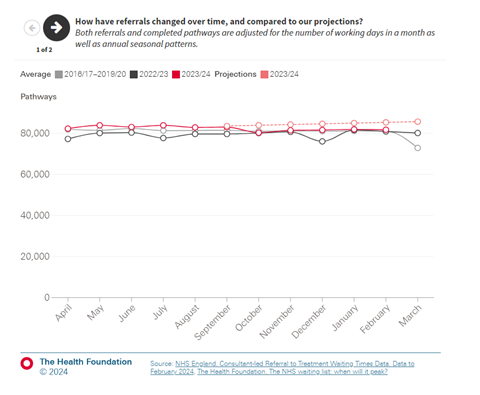Recovering services from the covid crisis is a big task for NHS leaders for the foreseeable future. The Recovery Watch newsletter tracks prospects and progress. This week by bureau chief James Illman.
Much of the debate around reducing the waiting list focuses on how trusts can ramp up elective activity, but how many patients join the list in the first place is just as important.
This critical component, which gets less air time than activity levels, was analysed in an interesting blog published by The Health Foundation last week.
The think tank’s calculations suggest referrals were lower than expected in recent months, which may even explain why the list has been falling since its 7.8 million peak in September.

Researchers analysed referrals and completed pathways adjusted for seasonal changes per working day with projections based on an assumption that referrals would continue to grow at the same rate as in the post-covid recovery period (see chart, left).
The chart shows the referrals projection for February was around 85,000, but there were only around 82,000 referrals. This pattern is repeated back to October when the list began falling.
The think tank’s senior analytical manager Kathryn Marszalek writes: “From October last year the number of referrals has been consistently lower than projected and is similar to pre-pandemic levels.”
The think tank says it’s unclear why referrals are not growing as expected. One possible reason is that the projections include some of the so-called missing patients not referred during covid belatedly coming forward, and referrals have now dropped back following this temporary spike. But it seems unlikely this would happen uniformly across England, the think tank says.
Another possible reason cited is the increased use of advice and guidance, where GPs consult specialists for advice before making a referral, effectively diverting a significant chunk of referrals off the main waiting list. But Ms Marszalek notes the number of A&G diversions per working day also appears to have fallen.
Other possible reasons cited in the blog are the pressure on primary care services, people’s ability to see a GP and the potential difficulties referring new patients to secondary care due to capacity constraints, all of which could lead to changes in referral behaviour.
Controlling referrals into the acute sector will of course be a key part of NHS England’s new elective recovery plan, work on which has begun cranking up in recent weeks.
An impending general election significantly complicates the plan’s development but the broad central principle for the new plan (as Recovery Watch revealed last month) is set, regardless of who forms the next government.
The new plan will aim to pivot away from a primary focus on reducing the longest waiters and to radically cutting the overall list size.
This is because the current plan, published in February 2022, set an original endpoint target that trusts would eliminate 52-week waiters by March 2025.
Despite the prime minister setting a target to reduce the waiting list overall (which was missed), the emphasis within the NHS, and the targets set for trusts, were always based on the 2022 elective recovery plan.
The plan has driven overall reductions in long waiters but has also fallen behind the run-rate, meaning the ‘end point’ will need to be pushed back. This happened to the March 2024 target to eliminate 65-week waiters, which was moved to September.
The speed at which the new plan pledges to reduce the list will of course be dependent on negotiations with the next government and with what pledges the parties put in their manifestos.
But NHS leaders are already bracing themselves for some challenging asks, especially if Labour win, as the polls suggest is the most likely outcome.
RW understands NHSE wants to be in a position where it can make an offer to a new government on what it thinks is deliverable and what it needs to do it.
While there is no due date for a new elective recovery plan, there is a due date for the productivity metrics which could help leaders forecast how quickly they could commit to reducing the overall list.
NHSE’s 2024-25 planning guidance committed to reporting “on productivity and supporting metrics at a national, ICB and trust level starting from the second half of 2024-25”.
While much of these will relate to reducing temporary staffing expenditure and removing off-framework agency use, there will also be a general focus on ramping up activity within a similar spending envelope.
This means we can also expect (yet another) attempt to improve theatre productivity this year, and (yet another) outpatient transformation plan, which is due to be published imminently. RW will track developments on both these critical elective recovery agendas.
Grasping the nettle on another difficult conversation
Another interesting report on elective efficiency was also published last week by the Centre of Perioperative Care. It surrounds the significant productivity hit dealt to the NHS by patients arriving for operations in a condition too unfit to undergo their procedure.
Figures suggest trusts in England are forced to cancel around 135,000 surgical procedures on the day each year, costing the service around £400m.
No one wants to tell a patient they’re not fit enough for an upcoming procedure, but it’s better to have that conversation than one on the proposed day of the operation.
Of course, even if patients are given fair warning about their fitness requirements, the onus is still on the patient to address them.
But the COPO report sets out how concerted action to turn waiting lists into “preparation lists” – with more screening and active support for patients to improve and maintain their health while they wait – could deliver significant benefits, including helping patients avoid the disappointment of a delayed op and delivering significant productivity benefits for the NHS.
The report added: “Better procedures to help patients drink, eat and mobilise after surgery can improve patient outcomes and reduce length of hospital stay, and better discharge planning can reduce readmission rates.”




























2 Readers' comments